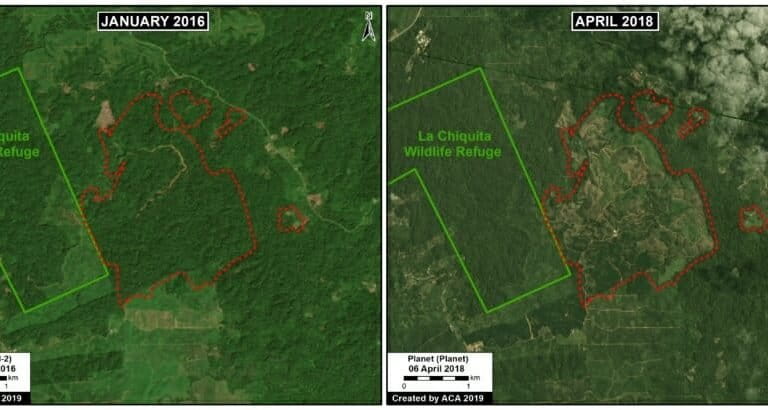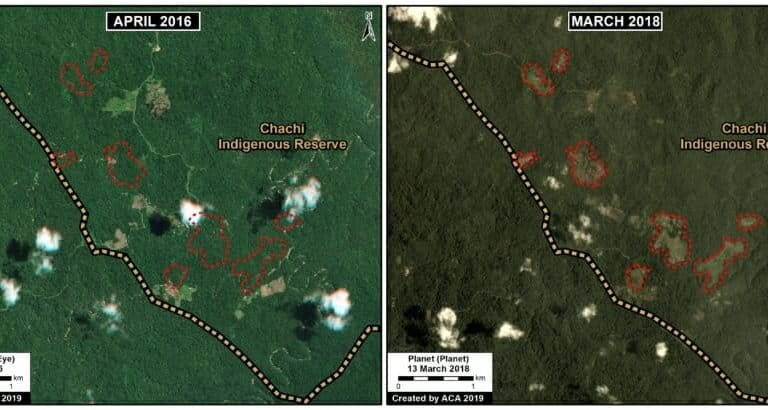- The Mache-Chindul Ecological Reserve maintains only 61 percent of its original plant cover. The area’s ecological significance is partly due to its sitting in a transition zone between humid tropical forests and seasonally dry forests.
- In Cotacachi-Cayapas Park, a high level of conservation success represents a source of hope. Now the challenge is to connect the park to private reserves to guarantee protection of the most-threatened lowland forests.
Spanning nearly 3 million hectares (7.4 million acres) along the coast, Ecuador’s Chocó region is known as a biodiversity hotspot with high levels of endemism, among the richest region for plants in the western hemisphere. However, this ecosystem is also one of the most threatened in the world. In Ecuador, it has been one of the most affected by deforestation in recent decades.
A recent analysis by the Monitoring of the Andean Amazon Project (MAAP), an initiative of the organization Conservación Amazónica (ACCA), reveals just how much forest has been lost. Overall, 61 percent (1.8 million hectares, or 4.4 million acres) of the Ecuadoran Chocó has been deforested; one-fifth of that loss (365,000 hectares, or 902,000 acres) occurred between 2000 and 2018.
The threats are many. According to Carmen Josse, scientific director of Fundación EcoCiencia, in Ecuador, these include industrial oil palm plantations as well as legal and illegal logging and mining. “In the highland areas, on the border of the Cotacachi-Cayapas Reserve, above 1,000 meters [3,300 feet], we are talking about very large mining concessions that have caused controversy among the local population, one of them in the Intag region, very close to the border of the Cotacachi-Cayapas Reserve. A few weeks ago, it was announced that abundant reserves of various high-quality minerals existed in this area.”
Endangered forests and the Mache-Chindul Reserve
Ecuadoran Chocó lowland forest experienced the lion’s share of deforestation, losing 68 percent (1.2 million hectares, or 3 million acres) of its forest cover by 2018. Middle- and high-elevation forests together were reduced by 50 percent (611,000 hectares, or 1.5 million acres), according to MAAP. Its analysis used data from Ecuador’s Ministry of the Environment for years before 2017, and the University of Maryland for 2017 and 2018.

The analysis found 4,600 hectares (11,400 acres) of Ecuadoran Chocó forest were deforested in 2017 and 2018, mostly in low-elevation forest.
According to MAAP’s analysis, only 39 percent of Ecuadoran Chocó forest (1.17 million hectares, or 2.89 million acres) remains. For lowland forest, located mainly in the province of Esmeraldas, only 32 percent (569,000 hectares, or 1.4 million acres) remains.
“This is dramatic because although it is a world biodiversity hotspot, it is one of the least appreciated,” Martin Schaefer, executive director of Fundación Jocotoco, told Mongabay Latam.
MAAP’s analysis reveals protected areas haven’t been immune, finding only 61 percent of Mache-Chindul Ecological Reserve retains its original forest.
Josse attributed this, to a certain extent, to there already being settlements inside this area from the time of its declaration in 1996. These include, on the one hand, indigenous Chachi communities, and on the other, migrants who moved there to work in agriculture.
“The declaration was complex, but it made sense, because it is an area that, although located in areas of low elevation near the coast, has a very rugged topography (consisting of a small coastal mountain range) that should not be used for agricultural activities. On the other hand, it also has high levels of endemism, because it is a transition zone between very humid forests, characteristic of the Chocó, and seasonally dry forests,” Josse said.

Josse said deforestation in the reserve has increased with the construction of nearby roads, among other things. “According to the evaluation of forest cover carried out by EcoCiencia in 2017, there are only 76,053 hectares [187,931 acres] of native forest left among the 200,000 [494,210 acres] in the area comprised of the district of Muisne and the Mache-Chindul Reserve,” notes the report “Oportunidades y desafíos en el manejo de los bosques y sus servicios ambientales en el cantón Muisne, Esmeraldas” (Opportunities and challenges in the management of forests and their environmental services in the district of Muisne, Esmeraldas), published by EcoCiencia last year. “If current rates of deforestation continue, in just 25 to 30 years the last remaining forests that exist in the area will be lost.”
In its report, MAAP highlights two areas significantly affected by deforestation. The first is a location close to the border with Colombia that lost 380 hectares (939 acres) between 2016 and 2018 “directly to the north of an oil palm plantation, possibly for an expansion.”
The analysis also reveals the Chachi Indigenous Reserve lost around 50 hectares (124 acres) of its forest cover between 2016 and 2018.
Hope in Cotacachi-Cayapas
Despite the loss of forest in many areas of the Ecuadoran Chocó, MAAP’s report offers optimism and hope in the high level of conservation of the recently named Cotacachi-Cayapas National Park, first declared protected in 1968 as an ecological reserve. MAAP’s data and images show that 99 percent of the park’s forests were in good condition as of 2018.
Schaefer from Fundación Jocotoco said Cotacachi-Cayapas remains important because it still has extensive forest coverage. However, he noted that the majority of land in the reserve is above 500 meters (1,640 feet), while the most threatened habitat in the Ecuadoran Chocó is the lowland forest, at elevations of less than 300 meters (980 feet).


“Our intention is to protect this habitat (of lowland forests) and then connect it to Cotacachi-Cayapas, because there is evidence that the species in the western area are moving their range of altitude upwards as a result of increasing temperatures, due to climate change. In order to facilitate this change in altitude we need this connectivity,” Schaefer said, adding that this is why Fundación Jocotoco is interested in expanding its Canandé reserve to connect it to the national park.
The aim is to move quickly, since the land in areas of low elevation is increasingly affected by road projects and “very suited to palm oil plantations,” Schaefer said. He added it is important to work with local communities and businesses that have sustainable models of production and that maintain a certain level of vegetation on their land, also providing a home for threatened species. “We want to demonstrate that there are alternatives for working in the forest without destroying its natural resources.”
Conservationists say the protection of the Ecuadoran Chocó has become a necessity due to the increasing pressures it faces.
“The area has also been affected by selective logging financed by large timber companies, and so these forests, those from which high-quality wood has been extracted, have gradually become degraded and have been converted to other land uses,” Josse said, adding that this is currently still happening.
If this loss of forest continues, Schaefer said, it will destroy a place of enormous biodiversity where “we are losing species, often before even discovering them.”
Banner image of forests in the highland areas of the Ecuadoran Chocó by Sebastián Crespo/CONDESAN.es-mongabay-com.mongabay.com













